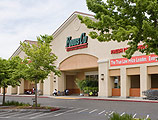“There is no there there.”
When Gertrude Stein wrote that deathless line about Oakland, it seems she wasn’t being snarky after all; she was grieving over the loss of her girlhood home to its path of growth. What would the poet say today? Oakland is popping: 2400 residential units built since 2016, another 1800 units under construction and 10,000 more in the entitlement process. If Gertrude were more civic booster and less nostalgic, she might say there’s a new there there.
While blessed with better weather, better transportation and more affordable housing than San Francisco, it also seems Oakland shares the same problems—both temporary and perhaps long- term—as its competitor across the bay. I asked an Oakland office building developer what Class A office space rents are today.
“Nobody knows,” he said. “There are no comps. No leases are getting signed.”
Same story with Class B office space according to a young developer with a portfolio of renovated downtown buildings. “There is only one office leasing requirement out there for the whole town—an engineering firm that needs 8,000 feet and everyone is chasing it.”
Apartment rents are off 15-25 percent while occupancy has dropped to about 90 percent. And let’s just say Oakland’s retail has been smacked and leave it at that.
These are temporary problems. Assuming the vaccines truly work—and enough of us take them—Oakland’s real estate will recover. But some of the city’s issues predate the virus by years and need more than a shot in the arm. Putting the heartbreak of homelessness aside, graffiti is Oakland’s posterchild problem. Its downtown has been relentlessly tagged. True, this is only a problem if you think of graffiti as quality-of-life destroying vandalism; if you think of taggers as joyfully revealing a city’s soul through their exuberant “street art”, Oakland is in the midst of a renaissance.
I asked a local landlord if my impression of taggers gone wild was wrong. “No, Oakland’s always been a graffiti hub; it’s far worse now for a couple reasons: one, with fewer pedestrians on the streets, the artists have no fear of getting caught; and two, the clean plywood sheets that owners put up to protect their buildings from the demonstrators make for perfect canvases.”
Couple that with a civic tolerance of street art and you have a situation that again, according to your tastes, renders the town either intolerably gritty or Berlin’s rival in authentic outdoor art. That Class A office developer said his company’s policy is to paint out graffiti the moment it appears, hoping to gradually wear down the persistent taggers. (In our experience, this is the only private solution). The obvious public solution—meaningfully punishing the street artists—doesn’t fly where progressive politicians ignore quality-of-life crimes, but here’s a suggestion for our lefty cities: Ban the sale of portable, tagger-sized spray paint cans. As hard as it is for landlords to believe, spray paint does have legitimate uses, but few that require a handy 12 ounce size. Make the model airplane builders use tiny spray cans and the commercial painters large, bulky ones and the paint wars might dry up.
Abruptly changing gears, one can damage real estate with a metaphorical broad brush just as easily as tagging it with Day-Glo orange. TreppWatch, a subscription service for the commercial lending world, reported in October that two property categories comprised 89 percent of the $4 + billion dollars’ worth of the real estate being handed back to the banks. You don’t need me to tell you those two categories were hotels and retail. But a story lies beneath this headline. On closer inspection, the Trepp numbers revealed that the hotel industry’s pain was centered on its full service sector; extended stay hotels accounted for only 1.31 percent of overall delinquencies. As for retail, six of its seven subcategories were basically unscathed: Super- regional malls accounted for only 4.9 percent of the bad loans, while the smaller properties—strip and neighborhood centers—totaled roughly 2 percent of the carnage. 82 percent of retail’s walking dead were found in a single cemetery—regional malls. So? The so is simple: If lenders fail to dig past the headlines, if they fail to differentiate among, say, retail’s very different animals and thus refuse to lend to the entire zoo, everyone suffers. Properties that should be developed or renovated or simply sold to more energetic ownership will be placed in commercial purgatory until the lending market returns. Without liquidity—without loans—the real estate market seizes up like a jeep with a busted oil pan. And properties in the hands of those who should be selling or redeveloping will languish, presenting the taggers with a herd of wounded antelopes. And cities with blocks of blight.






















